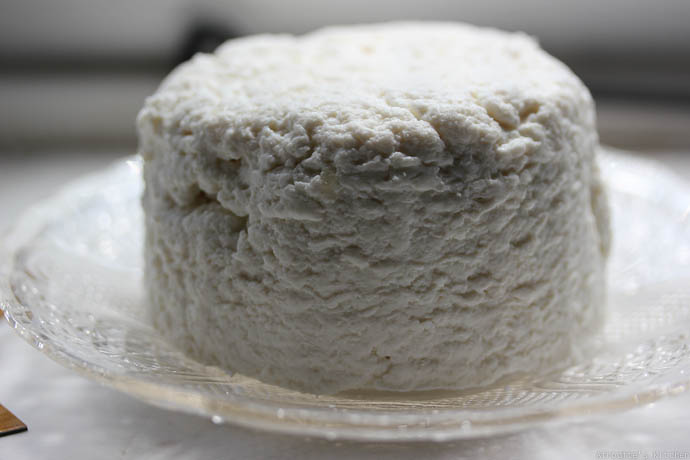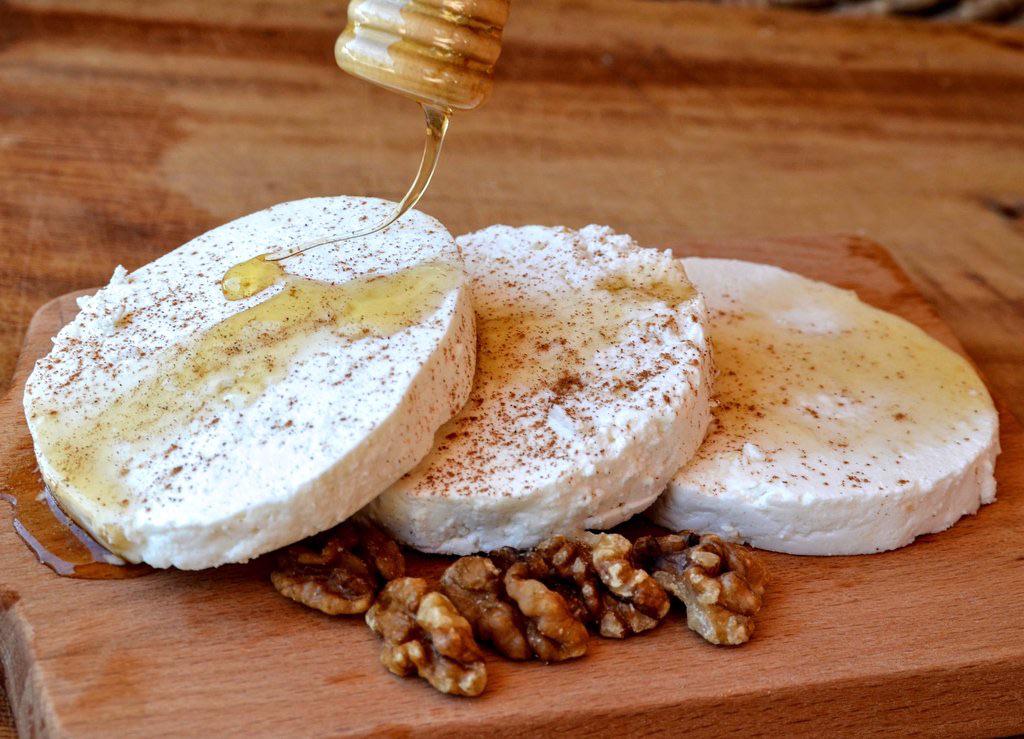What is Anari Cheese? Cyprus’ Creamy Culinary Secret

Nestled in the heart of the Mediterranean, Cyprus is a culinary treasure trove known for its unique and flavorful dishes. One such hidden gem is Anari Cheese, a creamy delight that’s as versatile as it is delicious.
Originating from the island’s pastoral traditions, Anari Cheese is a testament to Cyprus’ rich culinary heritage. It’s a soft, fresh whey cheese that carries a subtle yet distinct flavor, making it a beloved ingredient in both sweet and savory Cypriot dishes.
Quick Facts About Anari Cheese
| Quick Fact | Detail |
|---|---|
| Country of Origin | Cyprus |
| Type of Milk | Traditionally made from goat or sheep milk, but can also be made from cow’s milk. |
| Texture | Soft to semi-hard, similar to ricotta or cottage cheese when fresh; harder when matured. |
| Taste | Mild, slightly sweet with a hint of tanginess. |
| Color | White |
| Fat Content | Low fat content, especially if made from skimmed milk. |
| Pairing Suggestions | Pairs well with fruits, honey, and nuts for a sweet dish. Can also be used in savory dishes. |
| Cooking Uses | Versatile – can be used in cheesecakes, pies, pasta, salads, and more. |
| Nutritional Value | High in protein and calcium, low in fat (especially when made from skimmed milk). |
| Shelf Life | Short shelf life when fresh; longer when matured and salted. |
| Production Process | Made from the whey left over from making other cheeses like halloumi. |
| Availability | Mostly available in Cyprus and Greece, but can be found in specialty cheese shops worldwide. |
| Varieties | Comes in both fresh and matured varieties. The matured version is often harder and saltier. |
What is Anari Cheese?

Anari cheese is a hidden gem from the Mediterranean island of Cyprus. This fresh, mild whey cheese may be less known than its Cypriot sibling, halloumi, but it has started to gain recognition for its versatile and unique qualities. Produced traditionally from goat or sheep’s milk, Anari is a soft, ricotta-style cheese that offers a creamy, flaky, and brittle texture, making it a perfect addition to many dishes.
The flavor profile of Anari is best described as mild with a hint of sweetness. It’s a cheese that doesn’t impose itself but rather subtly enhances the flavors of the ingredients it’s paired with. Whether it’s served with fruits and honey for a sweet finish or incorporated into savory dishes like pasta and salads, Anari is a cheese that knows how to adapt.
Interestingly, Anari cheese is a byproduct of the halloumi cheese production process. The leftover whey from making halloumi is not wasted but instead transformed into this delightful cheese. This sustainable practice adds to Anari’s appeal, making it a favorite among eco-conscious cheese lovers.
Anari comes in two varieties: salted and unsalted. The unsalted version is typically used fresh and has a shorter shelf life, while the salted type can be matured, resulting in a harder, saltier cheese that can be stored for longer. This versatility further broadens the culinary possibilities of Anari, allowing it to take on different roles in the kitchen.
What Does Anari Cheese Taste Like?
The fresh version of Anari cheese is known for its soft texture and its mildly salty, slightly sweet taste. This unique flavor profile makes it a popular choice for breakfast, often served with honey or fruit.
We liken the taste of Anari to Romanian Urdă but with a more unified taste. It also bears a resemblance to Italian mozzarella, especially when it’s very soft. When Anari is sun-dried, it develops a mild salty taste, making it an excellent topping for pasta.
Anari is not just a delight for your taste buds, but it’s also a healthy low-fat choice. Despite its creamy and light texture, it contains a low quantity of fat. This cheese is consumed either fresh or dry, with the fresh Anari being white, soft, and having a mild sweet creamy taste.
Due to its neutral taste, Anari makes an excellent filling for both sweet and savory pies. When eaten fresh, it possesses a beautifully mild and creamy texture and taste, but when left to dry, it hardens and can be used like parmesan.
Anari Cheese Tasting Notes
Fresh Anari Cheese
- Appearance: Fresh Anari cheese presents a delicate, white color. Its appearance is similar to that of fresh ricotta, with a soft, moist, and slightly crumbly texture.
- Aroma: The aroma of fresh Anari cheese is subtle and inviting, reminiscent of fresh dairy notes with a hint of sweetness. There’s a refreshing, clean scent that evokes the feel of a Mediterranean morning.
- Taste: The flavor profile of fresh Anari cheese is mild, subtly sweet, and slightly salty. It has a gentle creaminess that doesn’t overpower but complements other ingredients well. The taste is often likened to fresh mozzarella or a less tangy cottage cheese.
- Texture: Fresh Anari has a creamy, yet somewhat grainy texture. It’s soft and easily spreadable, making it perfect for use as a topping or filling.
- Finish: The finish is clean and light, leaving a pleasant, slightly sweet aftertaste on the palate.
- Pairing: Fresh Anari pairs well with fruits, drizzled with honey, or sprinkled over salads. It’s also an excellent cheese for baking in sweet and savory dishes.
Dried Anari Cheese
- Appearance: Dried Anari cheese transforms into a harder, denser product. Its color deepens to a pale yellow, and it can be grated like Parmesan.
- Aroma: The aroma of dried Anari cheese becomes more robust due to the drying process. It develops an earthy, nutty smell that is more pronounced than its fresh counterpart.
- Taste: The taste of dried Anari cheese is more intense and saltier than the fresh version. It retains some of its original sweetness, but the flavor profile leans more towards the savory side.
- Texture: Dried Anari cheese has a hard, granular texture. It can be grated or shaved over dishes, adding a delightful crunch and depth of flavor.
- Finish: The finish of dried Anari cheese is long-lasting, leaving a rich, slightly salty aftertaste that lingers on the palate.
- Pairing: Dried Anari cheese works well grated over pasta, risotto, or soups. It also shines when used in cheese-based sauces or sprinkled over roasted vegetables. The robust flavor stands up well to strong flavors like garlic, herbs, and sun-dried tomatoes.
What is the Difference Between Anari Cheese and Ricotta?
Anari cheese and Ricotta are both soft, fresh cheeses, but they come from different regions and have distinct characteristics. Here’s a detailed comparison:
| Anari Cheese | Ricotta Cheese | |
|---|---|---|
| Origin | Cyprus | Italian |
| Production Method | The whey is heated until a combination of curds and single cream forms. The mixture is then strained and can be served either fresh or dried. | The whey is reheated until the remaining proteins coagulate and form fine curds. These curds are then scooped out and left to drain. |
| Texture | Fresh Anari has a soft, creamy texture. Dried Anari is harder. | Slightly grainy texture. |
| Taste | Fresh Anari has a slightly sweet and mildly salty taste. Dried Anari is saltier. | Mild, slightly sweet taste. |
| Usage | Fresh Anari is often eaten for breakfast with honey or fruit and used in cooking. Dried Anari is typically grated over pasta or used in sauces. | Versatile and used in many Italian dishes, from lasagna to cannoli. Also enjoyed fresh with fruits or honey, or spread on toast. |
Top 10 Best Anari Cheese Substitutes
| Cheese | Flavor Profile | Texture | Best Used In |
|---|---|---|---|
| Ricotta | Mild, slightly sweet flavor. | Soft, creamy texture. | Ideal for desserts, pasta fillings, and spreads. |
| Cottage Cheese | Mild, slightly tangy flavor. | Creamy with small curds. | Great in salads, spreads, or as a topping for dishes. |
| Mascarpone | Mild, slightly sweet flavor. | Very creamy, thick texture. | Perfect for desserts like Tiramisu and savory dishes. |
| Queso Fresco | Mild, slightly tangy flavor. | Soft, crumbly texture. | Excellent for Mexican dishes like tacos, salads, and enchiladas. |
| Feta | Tangy, salty flavor. | Soft, crumbly texture. | Ideal for Greek salads, sandwiches, and baked dishes. |
| Mozzarella | Mild, milky flavor. | Soft, moist texture. | Good for pizzas, caprese salad, and melted on various dishes. |
| Cream Cheese | Mild, slightly tangy flavor. | Soft, spreadable texture. | Works well in cheesecakes, spreads, and dips. |
| Neufchâtel | Mild, slightly tangy flavor. | Soft, creamy texture. | Great for spreads, dips, and desserts. |
| Boursin | Garlic and herb flavor. | Soft, creamy texture. | Excellent for spreads, dips, and as a topping for dishes. |
| Goat Cheese | Tangy, earthy flavor. | Soft, creamy texture. | Ideal for salads, spreads, and as a topping for dishes. |
What Pairs Well With Anari Cheese?

Food that goes well with Anari Cheese:
| Category | Food Pairings with Anari Cheese |
|---|---|
| Bread/Biscuits | Baguette, Crackers, Ciabatta, Whole Grain Bread |
| Fruits | Apples, Pears, Grapes, Figs |
| Meats | Prosciutto, Salami, Smoked Ham, Turkey |
| Vegetables | Tomatoes, Bell Peppers, Cucumbers, Olives |
| Nuts & Seeds | Almonds, Walnuts, Pine Nuts, Pumpkin Seeds |
| Condiments & Spreads | Honey, Fig Jam, Olive Tapenade, Apricot Preserve |
| Desserts | Dark Chocolate, Fruit Tarts, Cheesecakes, Baklava |
| Seafood | Smoked Salmon, Grilled Shrimp, Marinated Anchovies, Seared Scallops |
| Pasta & Grains | Ravioli, Gnocchi, Risotto, Orzo Salad |
| Herbs & Spices | Mint, Oregano, Basil, Black Pepper |
Also read: 11 Best Crackers that Pair Well with Cheese
Beverage that goes well with Anari Cheese:
| Category | Beverage Pairings with Anari Cheese |
|---|---|
| Wine | Chardonnay, Sauvignon Blanc, Pinot Grigio, Rosé |
| Beer | Wheat Beer, Pilsner, Saison, Belgian Ale |
| Non-Alcoholic | Apple Cider, Pear Juice, Iced Tea, Lemonade |
| Spirits & Cocktails | Limoncello, Aperol Spritz, White Russian, Gin & Tonic |
Also read: Best Wine and Cheese Pairings: The Ultimate Guide
Also read:
- What is Buttermilk Cheese? A Delicate Blend of Tanginess & Creaminess
- What is Whipped Cream? A Fluffy Delight in Every Spoonful
- What is Greek Yogurt? More Than Just a Dairy Product
- What is Crème Fraîche? Unpacking the French Culinary Staple
- What is Aged Cheddar? The Cheese That Stands the Test of Time
- What is Mizithra? Greece’s Gift to the Cheese World
- What is Goat Brie? A Unique Twist on a Classic Cheese





